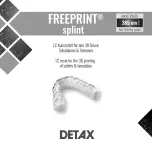
6
7
intended use
Resin for dental 3D printing
indication
Drilling and X-ray templates for implant dentistry, occlusal splints, fixation and transfer keys
Patient target grouP
Persons being treated in the context of a dental procedure.
intended users
Dentist, dental technician
suitable for the following dlP-Printer
Processing
►
The properties of the final product depend, among other things, on post-processing. Correct post-exposure is
important for biocompatibility. Therefore it must be ensured that the light unit is in an orderly condition and that the
moulds are completely cured (observe processdescription on page 2).
►
After storage, the material in the bottle should be shaken intensively and homogenized with a bottle roller before use.
►
Minimum material thickness for the design is 1.5 mm
►
Maximum curing depth* at direct post-exposure: clear: 3,5 mm
*In case of large objects and exposure on both sides, the material thickness can be up to 7 mm
(Example FREEPRINT® splint – with a curing depth of 3,5 mm).
Do not use heat-based methods for disinfection or sterilisation. This could possibly deform the workpiece.
►
Seal surface with FREEFORM® coat.
►
Processing temperature 23 °C ± 2 °C.
safety information
►
Only for the specified intended use by trained specialists.
►
Avoid direct contact with the liquid material and the components before post-curing, especially in pregnant /
breastfeeding women. Irritating to eyes and skin (sensitization possible).
►
Wear personal protective equipment (protective gloves, goggles) when handling the uncured material.
►
Wear suitable personal protective equipment (protective gloves, goggles, face mask) when finishing the cured material.
►
After contact with eyes rinse thoroughly with water immediately and consult a doctor.
►
After contact with skin wash immediately with water and soap.
►
Biocompatibility is only guaranteed with complete polymerisation.
►
Wear suitable personal protective equipment (protective gloves, goggles, face mask) when finishing the cured material.
►
Refer to the relevant safety data sheet for hazard and safety information.
cleaning
by dental laboratory / practice
In dental laboratories and practices, the cleaning is done in ultrasonic baths.
by the patient
For daily cleaning, use lukewarm water, a soft toothbrush, liquid soap or detergent. Then rinse well afterwards. Cleaning
tablets can be used following the manufacturer’s instructions.
note
►
Do not use toothpaste; the abrasive particles are coarse and scratch the surface.
►
Do not use any acids or solvents.
notes
►
DETAX shall not be held liable for any damage caused by misuse.
►
Always keep container tightly sealed, immediately close the container carefully after each use.
►
Please follow the instructions on the safety data sheet!
for users and/or patients:
Any serious incidents occurring in relation to this product should be reported immediately to [email protected] and to
the competent authority of the Member State in which the user and/or patient is established.
storage
freePrint® splint
is to be stored dry (at 15 °C - 28 °C) and protected from light. Minimal influence of light can already
induce polymerisation.
contraindication
Contains (meth)acrylics and phosphine oxide.
Some ingredients of
freePrint® splint
may cause allergic reactions in predisposed persons. In such cases refrain from
using the product.
freePrint® splint
only insert intraorally in completely polymerised state.
adVerse effects
Product may cause allergic reactions.
disPosal
Disposal of the contents/container must be carried out in accordance with the local/regional/national and international
regulations.
EN
EN
Printers may only be operated using material parameters authorised by DETAX!
Medical Device
storage:
symbols:
15 °C
59 °F
28 °C
82 °F
application:
At 23 °C ± 2 °C
rapidshape
385 nm
DII-Serie
w2P
385 nm
Solflex-Serie
miicraft
385 nm
MiiCraft y-Serie
asiga
385 nm
385 nm
405 nm
MAX UV
Pro2 UV
Pico2 UV
MAX 405
Pro2 405
Pico2 405
405 nm
D-Serie
Содержание FREEPRINT split
Страница 1: ......
Страница 36: ...70 71 Notes...





































